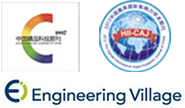Abstract:
Zirconia fiber reinforced polymethyl methacrylate polymethyl acrylate ( PMMA-PMA) mat rix composites were prepared using a suspension polymerization process. The influences of monomer ratio , initiator dosage andfiber content on the mechanical properties of the composites were particularly investigated. The flexural st rength andmicrost ructure of the composites were characterized by the universal testing machine , SEM and XRD analyses. Theresult s show that the flexural st rength of the composites reaches the optimum value when the volume ratio of methylmethacrylate and methyl acrylate (MMA/ MA) is 9∶1. With the increase of benzoyl peroxide (BPO) content , theflexural st rength of ZrO
2 (f) / PMMA-PMA composites increases to a maximum and then decreases. With the increaseof ZrO
2 fiber content , the morphologies of the fractured surfaces change from smooth to crapy , indicating that thetoughness of the composites is improved.


 下载:
下载: